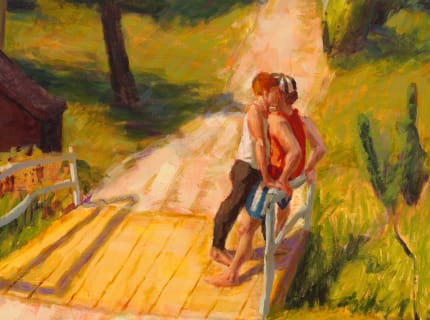New York City’s cramped tenement apartments were the standard setting for painter Hugh Steers (1962–1995). Within these intimate environs, Steers most often depicted male figures—alone or in pairs—in various states of solemn embrace and ailing woe, evoking the emotional carnage of the AIDS crisis, which ravaged the queer community and claimed Steers’s own life when he was thirty-two. For the exhibition “Day Light” at Alexander Gray Associates, these signature interior scenes were paired with a lesser-known group of outdoor pieces Steers made while in residence at the Skowhegan School of Painting and Sculpture in idyllic Madison, Maine, in 1991. Together, the two bodies of work illuminate, quite literally, the artist’s deft handling of natural light, both indoors and out. The show also revealed the psychological through line of Steers’s paintings: a “soft glow of brutality” that the artist said marks the American scene.
The rural surroundings of Madison allowed Steers to try his hand at renderings of the sun’s rays shining across verdant landscapes. In works such as Raft and Telephone Poles, both 1991, daylight falls on lush greenery and rippling water in vivid hues and evinced by choppy, impressionistic brushstrokes. These outdoor paintings evoke the accessible American Regionalism of Grant Wood or Thomas Hart Benton, yet they also evince uneasy undercurrents: In both works, a lone figure stands in a landscape with a paper bag over his head. This ambiguous yet fraught motif recurs throughout Steers’s oeuvre, shrouding his pictures in an apprehensive air.

